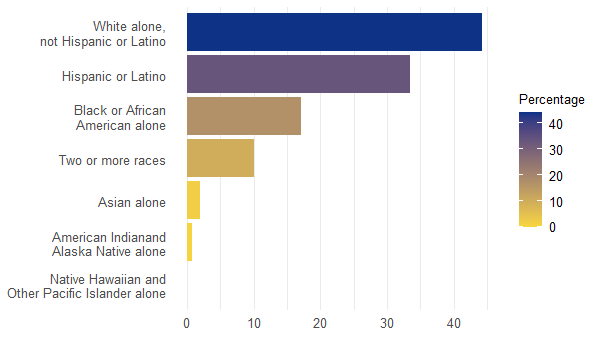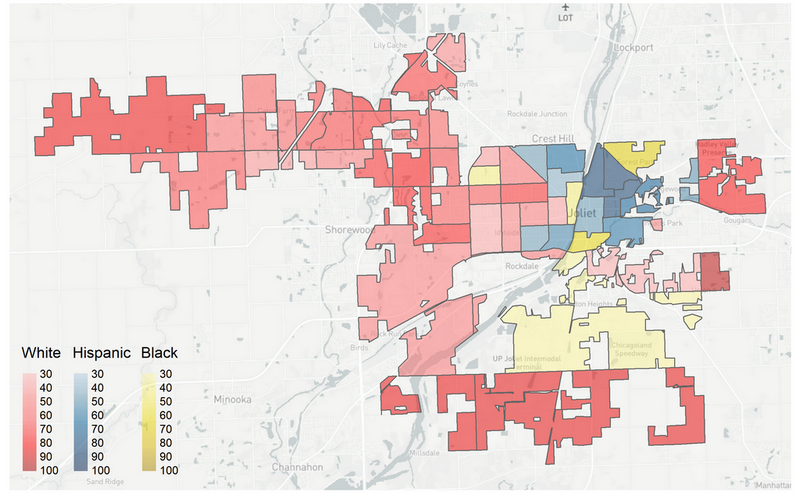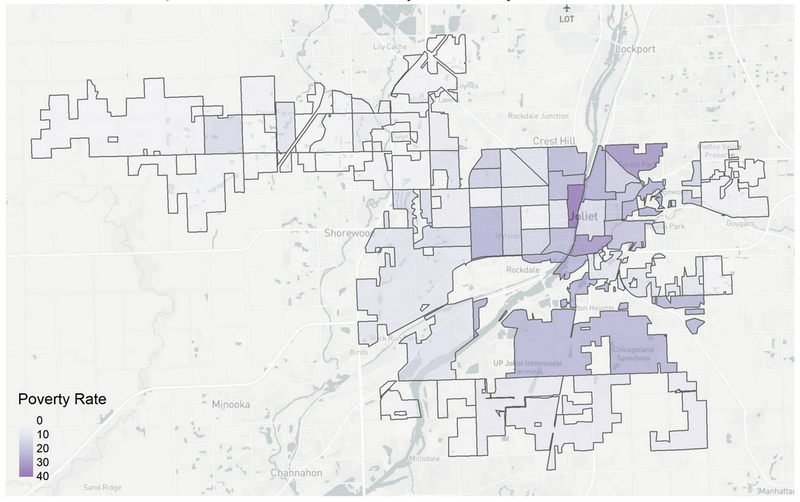Joliet is the third largest city in Illinois with an estimated population of 150,000. Located in Will and Kendall counties, Joliet is home to a dynamic arts, culture, and sports scene. The historic Rialto Square Theatre anchors Joliet’s downtown city center and features year-round entertainment options. The Joliet Area Historical Museum hosts special and permanent exhibits and also operates tours and events at the Old Joliet Prison. The Illinois Rock & Roll Museum is in the process of renovating a new building in downtown Joliet that will feature a performance music hall and exhibit space. The Joliet Public Library operates two branches and offers residents a summer reading program, traveling exhibits, and citizenship classes. And the Joliet Slammers are a professional baseball team that competes in the independent Frontier League.

Aerial view of downtown Joliet
Joliet is also home to institutions of higher learning. Joliet Junior College (JJC), founded in 1901, was the first public community college in the United States; JJC is a fixture in the community and offers nine academic pathways across six campuses and serves over 30,000 students annually. In addition, the University of St. Francis offers undergraduate, graduate, and certificate programs to over 3,000 residential and commuter students.
The racial and ethnic composition of Joliet is approximately 44.3% White alone (not Hispanic or Latino), 33.5% Hispanic or Latino (of any race), 17.1% Black or African American alone, and 2.0% Asian alone; 10.1% of Joliet’s population identifies as bi-racial or multi-racial.[1]
Population of Joliet by Race

Of the ten most populated cities in Illinois, Joliet is the third most diverse city, behind Chicago and Aurora, and is more diverse than other similarly sized cities in the state like Rockford and Naperville. The city encompasses approximately 63 square miles and is located about 40 miles southwest of Chicago.
Like many cities across the United States, Joliet’s neighborhoods show patterns of racial segregation. Census tract data indicates that Joliet’s Black, Hispanic or Latino,[2] and multi-racial-majority communities are concentrated in the city’s central and east areas, to the east of the Des Plaines River dividing the city, while White-majority neighborhoods exist almost exclusively outside of the city center.
Figure 1: Percent of Population for Largest Racial/Ethnic Group by Census Tract

Nearly 11% of Joliet residents live below the federal poverty line, which is slightly less than the state (11.6%) and national (12.5%) poverty rates. When broken down by race, Joliet’s Black or African American population is more than twice as likely to be affected by poverty as the city’s White population (19.7% as compared to 8.1%).
Figure 2: Percent of Population Below Poverty Level by Census Tract

The average unemployment rate in Joliet was 3.0% in 2023, which is similar to the average unemployment rate of the state (3.1%) and slightly higher than that of the country (2.7%). About 25% of Joliet’s population over the age of 25 holds a bachelor’s degree or higher, which is lower than the state and national educational attainment rates (38% and 36%, respectively). There are significant disparities in educational attainment among Joliet’s racial and ethnic groups. White people in Joliet are much more likely to hold a bachelor’s degree or higher than Black people (30.1% compared to 21.3%), and nearly 2.4 times as likely as people of Hispanic or Latino origin (30.1% compared to 12.7%).
Joliet has a home ownership rate of 72.4%, which is higher than the state and national rates of home ownership (66.7 and 64.85%, respectively). However, housing insecurity does affect some people in Joliet. According to the U.S. Department of Housing and Urban Development, an estimated 343 people in Joliet and surrounding areas were experiencing homelessness in January 2023.[3] In recent years, the Joliet city council has voted down two proposals to expand homeless shelter options to accommodate Joliet’s growing homeless population.[4]
The City of Joliet works under a council-manager form of government, in which the city council determines local policy matters and enacts legislation with the mayor presiding. The mayor of Joliet is Terry D’Arcy, who took office in May 2023. Robert O’Dekirk, a former JPD officer, served as mayor from 2015 to 2023. Joliet’s city council consists of eight members—five serve as district councilpersons and three as councilpersons at large.
The Joliet city manager oversees government administration. The city manager is appointed by the city council and reports to council and the mayor. Among other responsibilities, the city manager has authority to hire and remove the chief of police, the deputy chiefs, and other members of the Joliet Police Department who are not part of a collective bargaining unit. The city manager of Joliet is Beth Beatty, who has served in this position since December 2023. Joliet has had two permanent and four interim city managers in the past seven years.
The Joliet Police Department is one of the largest law enforcement agencies in Illinois, and is budgeted for 286 sworn members, 68 full-time civilians, 3 part-time civilians, and 44 crossing guards. As of July 2024, JPD had 262 sworn members, leaving about 8% of its sworn member positions vacant. The racial and ethnic composition of JPD sworn members is about 77% White (not Hispanic or Latino), 11% Black (not Hispanic or Latino), 1% Asian, and 11% Hispanic or Latino (any race). Approximately 85% of JPD’s sworn members are male. JPD’s annual budget is $67 million, which constitutes about 30% of the City’s total general fund budget.[5]
JPD is divided into four divisions: Operations, Investigations, Administration, and Technical Services. The Operations Division is the largest division of the Department with approximately 200 members, most of whom are assigned to patrol. Patrol is divided into three districts (east, central, and west), and each district is divided into six sectors.[6] In addition to patrol, the Operations Division also includes the neighborhood-oriented policing team and the special services, traffic, and K-9 units. The Investigations Division largely consists of detectives who work in the general assignment unit or in a specialized unit (e.g., evidence, criminal intelligence, tactical, narcotics, school liaisons, and various task forces). The Administration Division includes Internal Affairs—which investigates allegations of police misconduct—as well as sworn members and civilians responsible for training, planning and accreditation, public affairs, crime analysis, and social services. The Technical Services Division largely consists of civilian staff, and it includes the 911 Communications Center and records section.
JPD’s command staff includes the Chief of Police and four Deputy Chiefs, who each oversee one of the four divisions. William Evans has been JPD’s Chief of Police since March 2022. He is the fifth JPD chief in seven years. Robert Brown, Deputy Chief of Operations, acted as interim Chief from October 2021 to March 2022. Dawn Malec became the first woman to lead JPD as Chief in February 2021. Malec was removed from the position in October 2021, and she retired from JPD in July 2022 at the rank of lieutenant. Alan Roechner served as Chief, first in an interim capacity and then as permanent Chief in December 2018, until his retirement in January 2021. Brian Benton served as Chief from 2013 until his retirement in late 2018.
The Illinois Fraternal Order of Police (FOP) Labor Council represents the bargaining interests of rank-and-file JPD officers. The Illinois FOP Labor Council—Joliet Police Supervisors Association represents sergeants and lieutenants. Each union has a separate collective bargaining agreement with the City. JPD also has a chapter of the National Black Police Association, which is a national network of Black police associations whose mission is to promote justice, fairness, and effectiveness in law enforcement. Membership in JPD’s Black Police Officer Association is voluntary and is not limited to officers who identify as Black.
